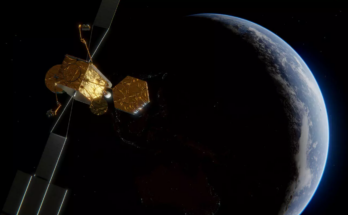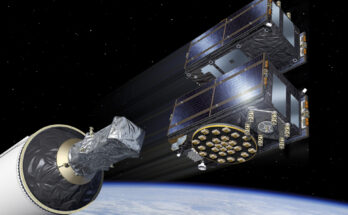By Bill Ostrove, Space Systems Analyst, Forecast International.
While small satellites and CubeSats are becoming increasingly popular, large geosynchronous Earth-orbiting (GEO) communications satellites maintain an important role in the space industry. Illustrating that importance was the announcement on September 5 that Eutelsat Communications and Facebook will partner on a new initiative to deliver Internet access across Africa.
The two companies signed a multiyear contract with Spacecom to use the entire broadband payload of the AMOS-6 satellite. The AMOS-6 will be a traditional GEO satellite, with a launch mass of around 5,500 kilograms. It will incorporate new technologies, such as spot beams and frequency reuse, to increase the capacity available for sale. Additional capacity increases the revenues generated per transmitter, allowing satellite operators to provide increased speeds at lower costs to customers while increasing their own profitability. Facebook and Eutelsat will build a dedicated system comprising satellite capacity, gateways, and terminals.
The capacity will enable Eutelsat to step up its broadband activity in sub-Saharan Africa that was initiated using Ku-band satellites to serve professional users. Eutelsat is establishing a new company based in London that will steer its African broadband vision and business. The new company will be led by Laurent Grimaldi, founder and former CEO of Tiscali International Network, and will focus on serving premium consumer and professional segments.
The move is particularly interesting in that Facebook is one of the partners in the deal. Silicon Valley companies are investigating disruptive technologies to provide broadband Internet to developing countries.
For example, Facebook started Internet.org two years ago in an effort to increase levels of connectivity around the world. Internet.org addresses physical, economic, and social barriers that keep people from getting online. It is similar to Google’s Project Loon, which also funds projects to get people online. Companies have explored using everything – from balloons to small satellites to drones – to provide Internet to Africa and other developing regions.
Despite investigations into disruptive technologies, large geosynchronous satellites still prove useful in providing connectivity to people around the world. New technologies, such as spot beams and frequency reuse, have made them more attractive. Deliveries of these large spacecraft will continue at steady levels going forward.
A military history enthusiast, Richard began at Forecast International as editor of the World Weapons Weekly newsletter. As the Internet grew in importance as a research tool, he helped design the company's Forecast Intelligence Center and currently coordinates the EMarket Alert newsletters for clients. Richard also manages social media efforts, including two new blogs: Defense & Security Monitor, covering defense systems and international issues, and Flight Plan, which focuses on commercial aviation and space systems. For over 30 years, Richard has authored the Defense & Aerospace Companies, Volume I (North America) and Volume II (International) services. The two books provide detailed data on major aerospace and defense contractors. He also edits the International Contractors service, a database that tracks all the contractors involved in the programs covered in the FI library. More recently he was appointed Manager, Information Services Group (ISG), a new unit that encompasses developing outbound content for both Forecast International and Military Periscope.




